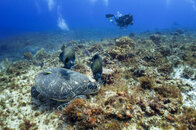Sorry Dogbowl but your topic sounded just about right for my question:
Tips for underwater photography during a drift dive? I find u photography challenging enough anyway but at a location like Cozumel where the current means constant motion 95% of the dive how does one compose an image? Obviously I don't want to grab or even touch the reef so I generally just to try compose the image on the "fly" and capture it as I go by but that usually means one or maybe two shots before I am out of position. Any tips, tricks or advice appreciated.

Tips for underwater photography during a drift dive? I find u photography challenging enough anyway but at a location like Cozumel where the current means constant motion 95% of the dive how does one compose an image? Obviously I don't want to grab or even touch the reef so I generally just to try compose the image on the "fly" and capture it as I go by but that usually means one or maybe two shots before I am out of position. Any tips, tricks or advice appreciated.




